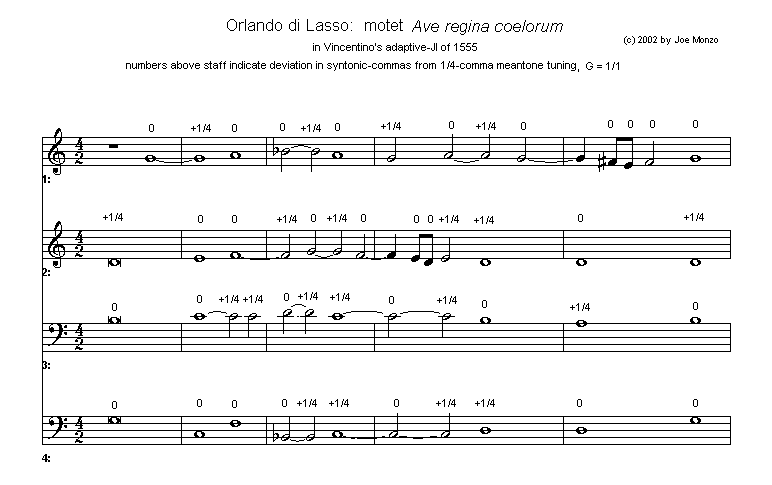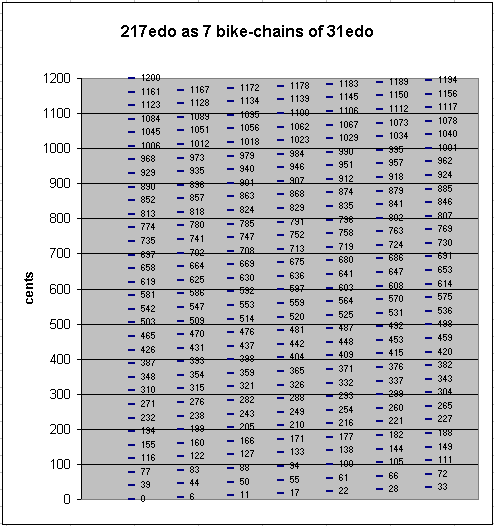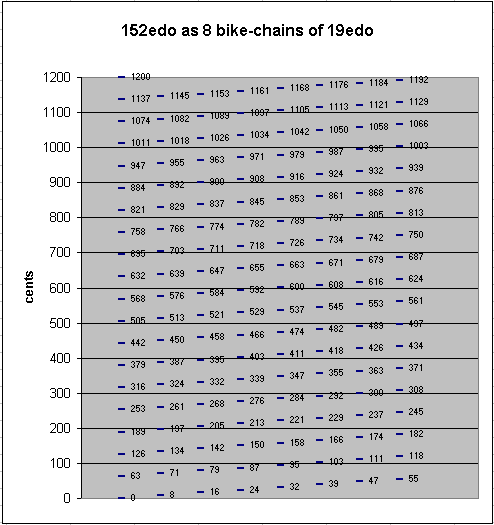adaptive JI
[Joe Monzo, with Paul Erlich]
A form of temperament in which some algorithm is used which keeps the ratios of simultaneous sounds exactly in just-intonation, but uses non-JI melodic intervals to reduce the retuning motion and/or drift relative to a strict JI realization.
For example, the G you sing in one chord might be a little higher or lower than the G you sing in the next chord. But each G would be perfectly in tune with the chord it appears in.
While retuning motions and/or drifts in strict JI renditions are one or more commas in magnitude, adaptive JI reduces these to fractions of a comma by spreading the motion among all the chord changes in a progression.
The desideratum, at least in more modern times (making use of the computer) is usually to allow dynamic alterations of the pitches during the performance of the music.
Various approaches have been tried, one of the earliest examples being by Nicola Vicentino in the 1500s. In 1999, John deLaubenfels and Paul Erlich were very active in developing a good Adaptive JI algorithm. deLaubenfels explains his method in detail in these Tuning List posts: Wed Jan 19, 2000 3:24 am and Tue Sep 12, 2000 3:09 pm.
Below is a musical illustrations of the first 5 measures of Orlando di Lasso's motet Ave regina coelorum, tuned in Vicentino's adaptive-JI tuning. This particular example was chosen specifically because it is used as an illustration by Easley Blackwood of the unsuitability of strict-JI for "common-practice" repertoire because of the problem of drift (see Blackwood 1985, p 133-135). The illustration uses 1/4-comma meantone as the basis for the notation of letter-names and accidentals, and shows the deviation of Vicentino's tuning from that. [click on the illustration to hear a MIDI-file of it]

. . . . . . . . .
[Paul Erlich]
Paul Erlich made the following comment:
In adaptive JI the pain of having vertical sonorities deviate from JI is infinite, while in adaptive tuning, all the different components of pain get traded off against one another.
. . . . . . . . .
[Paul Erlich]
Paul Erlich posted the following in a Tuning List posting, Wed Oct 18, 2000 9:03pm
The idea of adaptive tuning goes back to Vicentino in 1555, who proposed the two chains of 1/4-comma meantone tuning a pure fifth (or equivalently, a pure minor third, or 1/4 comma) apart.
This proposal would never compromise the melodic integrity of the chain of identical (in this case, meantone) fifths by more than a melodically inaudible interval, 1/4-comma, while attaining perfect vertical JI in all triads.
To me, this amounts to audibly "perfect" tuning within the Renaissance theoretical ideal (as expressed by, say, Zarlino), and much of the subsequent repertoire well into the 18th century -- until enharmonic equivalents began to be used.
Though Vicentino's two-keyboard implementation was not practical at the time, with computers (or, perhaps, AFMM performers), we can acheive his goals, and even surpass him in cases where his proposal runs into difficulties.
. . . . . . . . .
[Paul Erlich]
From Paul Erlich, Yahoo Tuning Group, message 32139
Date: Sat Dec 29, 2001 9:57 pm
Subject: Re: Freestyle misunderstood
Lou Harrison's freestyle strikes me as one of the two types of "Strict JI", so I wouldn't call it "Adaptive JI". The two types of Strict JI would be
- (a) one with a finite set, though not necessarily closed, set of fixed pitches, so that drift doesn't occur; and
- (b) one with a potentially infinite use of pitches from the JI lattice, with a preference for observing common tones, so that drift may occur.
I've called the former "Fixed-pitch JI" and the latter "Freestyle JI" -- the term "strict" qualifies both these subcategories.
. . . . . . . . .
[Joe Monzo]
217-edo provides, among other things, an excellent set of pitches to achieve fixed-pitch adaptive-JI. Below is an illustration of how 217-edo may be considered as 7 bike-chains of 31-edo, each approximately 1/4-comma apart.

Below is an example by Dave Keenan of a I-VI-II-V-I "comma-pump" chord progression, written in the "sagittal" notation developed by he and George Secor in 2002, and tuned by Monzo in 1/4-syntonic-comma adaptive-JI (click on the graphic to hear the MIDI-file).

152edo is a more concise fixed-pitch tuning which works as adaptive-JI, in the form of 8 bike-chains of 19-edo, each separated by approximately 1/3-comma.

. . . . . . . . .
References
Vicentino, Nicola. 1555.
L'antica musica ridotta alla moderna prattica
["ancient music restored to modern practice"]
Antonio Barre, Rome. republished 1557.
English translation:
Ancient music adapted to modern practice
Maria Rika Maniates (ed.), Claude V. Palisca (ed.),
Yale University Press, New Haven CT, 1996, p. xlix.
Blackwood, Easley. 1985.
The Structure of Recognizable Diatonic Tunings
Princeton University Press, Princeton, NJ.
ISBN 0-691-09129-3
. . . . . . . . .




